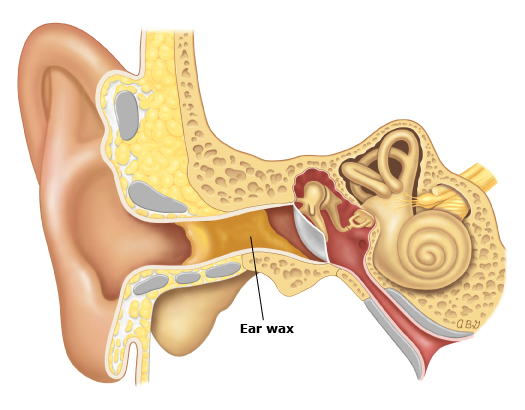Ear Wax Removal
.png)
What is Ear Wax?
Earwax, known in medical terms as Cerumen, is a sticky secretion formed in the ear canal of humans and other mammals. It protects the skin of the ear canal, lubricates and helps to provide protection against bacteria, fungi and other foreign objects that might get into the ear
Problems with Ear Wax Build Up
The body knows how much ear wax to produce, your ears will also naturally expel excess ear wax.
Unfortunately, you can get a build-up of excessive ear wax which can become compacted leading to hearing impairment.
Things like using ear plugs or in ear earphones inserted too deeply into the ear, can compact ear wax into the inner ear. Also manually removing ear wax with items like cotton buds can also push ear wax deposits into the inner ear, this has the added effect of your ears sending out a signal to top up the manually removed ear wax, but also adding more ear wax on top of the compacted ear wax created by the manual removal.
Signs that you may be suffering with a build-up of ear wax.
Impaction of the ear with discharge, debris, wax, or a foreign body can often result in discomfort, pain, ringing in the ear, and hearing impairment
"Following water precautions and avoiding the use of cotton buds can prevent recurrence of wax impaction and the requirement for further microsuction." (quote from the British medical journal)
What Is Microsuction?
.png) Microsuction is a technique for removing ear wax or debris from inside the ear using an endoscope. This allows the clinician to precisely visualise the location of the ear wax, once located the ear wax is removed by a specialised sterile machine using low pressure suction to safely remove deposits of ear wax.
Microsuction is a technique for removing ear wax or debris from inside the ear using an endoscope. This allows the clinician to precisely visualise the location of the ear wax, once located the ear wax is removed by a specialised sterile machine using low pressure suction to safely remove deposits of ear wax.
This is also known as ‘Endoscopic Microsuction’ it is a safe sterile procedure carried out by professional’s to give you the most effective and comfortable solution to a build-up of ear wax. It is a noisy procedure and although some patients may find the procedure slightly uncomfortable it should not be painful.
What is Irrigation?.png)
One of the most frequent ways to remove wax in general practice is by ear irrigation, or syringing as it is commonly known. This procedure cannot be carried out if the person has had any ear surgery, recent infections or a perforation of the ear drum. It is also not advisable to carry out the procedure if the patient has any dizziness problems or very troublesome tinnitus.
During this procedure, the person sits in a chair and the ear is rinsed with warm water from an electronic irrigator. The wax and water is collected in a cup-shaped receiver which the patient holds under their ear. In the past clinicians used a large metal syringe; however the new electronic irrigators, which have controlled pressures, are gentler and safer. Ear syringing does make some noise but this is not excessive or uncomfortable. Most people who have irrigation find it to be a fairly pleasant procedure.
Manual Wax Removal
Wax may also be removed manually by a clinician using a headlight and instruments. Never try to remove the wax yourself with an instrument or device as you will most probably push it further down the ear canal or cause damage.
There are two types of ear wax removal:Irrigation and Microsuction
Home visits available for an extra £20 pound within a 25 mile radius from any of our centres. If you require a visit that is further than 25 miles, please contact us for a quote.
Click Here to find a local center